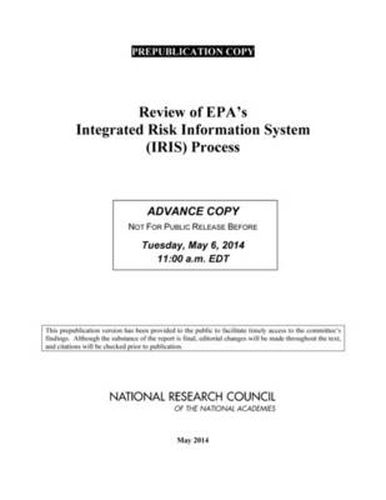Readings Newsletter
Become a Readings Member to make your shopping experience even easier.
Sign in or sign up for free!
You’re not far away from qualifying for FREE standard shipping within Australia
You’ve qualified for FREE standard shipping within Australia
The cart is loading…






The Integrated Risk Information System (IRIS) is a program within the US Environmental Protection Agency (EPA) that is responsible for developing toxicologic assessments of environmental contaminants. An IRIS assessment contains hazard identifications and dose-response assessments of various chemicals related to cancer and noncancer outcomes. Although the program was created to increase consistency among toxicologic assessments within the agency, federal, state, and international agencies and other organizations have come to rely on IRIS assessments for setting regulatory standards, establishing exposure guidelines, and estimating risks to exposed populations. Over the last decade, the National Research Council (NRC) has been asked to review some of the more complex and challenging IRIS assessments, including those of formaldehyde, dioxin, and tetrachloroethylene. In 2011, an NRC committee released its review of the IRIS formaldehyde assessment. Like other NRC committees that had reviewed IRIS assessments, the formaldehyde committee identified deficiencies in the specific assessment and more broadly in some of EPA’s general approaches and specific methods. Although the committee focused on evaluating the IRIS formaldehyde assessment, it provided suggestions for improving the IRIS process and a roadmap for its revision in case EPA decided to move forward with changes to the process. Congress directed EPA to implement the report’s recommendations and then asked the National Research Council to review the changes that EPA was making (or proposing to make) in response to the recommendations. Review of EPA’s Integrated Risk Information System (IRIS) Process provides an overview of some general issues associated with IRIS assessments. This report then addresses evidence identification and evaluation for IRIS assessments and discusses evidence integration for hazard evaluation and methods for calculating reference values and unit risks. The report makes recommendations and considerations for future directions. Overall, Review of EPA’s Integrated Risk Information System Process finds that substantial improvements in the IRIS process have been made, and it is clear that EPA has embraced and is acting on the recommendations in the NRC formaldehyde report. The recommendations of this report should be seen as building on the progress that EPA has already made.
$9.00 standard shipping within Australia
FREE standard shipping within Australia for orders over $100.00
Express & International shipping calculated at checkout
The Integrated Risk Information System (IRIS) is a program within the US Environmental Protection Agency (EPA) that is responsible for developing toxicologic assessments of environmental contaminants. An IRIS assessment contains hazard identifications and dose-response assessments of various chemicals related to cancer and noncancer outcomes. Although the program was created to increase consistency among toxicologic assessments within the agency, federal, state, and international agencies and other organizations have come to rely on IRIS assessments for setting regulatory standards, establishing exposure guidelines, and estimating risks to exposed populations. Over the last decade, the National Research Council (NRC) has been asked to review some of the more complex and challenging IRIS assessments, including those of formaldehyde, dioxin, and tetrachloroethylene. In 2011, an NRC committee released its review of the IRIS formaldehyde assessment. Like other NRC committees that had reviewed IRIS assessments, the formaldehyde committee identified deficiencies in the specific assessment and more broadly in some of EPA’s general approaches and specific methods. Although the committee focused on evaluating the IRIS formaldehyde assessment, it provided suggestions for improving the IRIS process and a roadmap for its revision in case EPA decided to move forward with changes to the process. Congress directed EPA to implement the report’s recommendations and then asked the National Research Council to review the changes that EPA was making (or proposing to make) in response to the recommendations. Review of EPA’s Integrated Risk Information System (IRIS) Process provides an overview of some general issues associated with IRIS assessments. This report then addresses evidence identification and evaluation for IRIS assessments and discusses evidence integration for hazard evaluation and methods for calculating reference values and unit risks. The report makes recommendations and considerations for future directions. Overall, Review of EPA’s Integrated Risk Information System Process finds that substantial improvements in the IRIS process have been made, and it is clear that EPA has embraced and is acting on the recommendations in the NRC formaldehyde report. The recommendations of this report should be seen as building on the progress that EPA has already made.